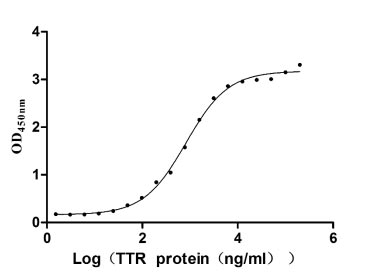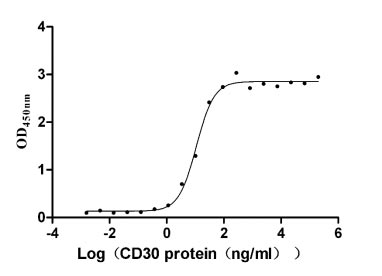Recombinant Mouse Transcriptional repressor CTCF (Ctcf), partial
-
中文名称:Recombinant Mouse Transcriptional repressor CTCF(Ctcf),partial,Yeast
-
货号:CSB-YP726738MO1
-
规格:
-
来源:Yeast
-
其他:
-
中文名称:Recombinant Mouse Transcriptional repressor CTCF(Ctcf),partial,Yeast
-
货号:CSB-EP726738MO1
-
规格:
-
来源:E.coli
-
其他:
-
中文名称:Recombinant Mouse Transcriptional repressor CTCF(Ctcf),partial,Yeast
-
货号:CSB-EP726738MO1-B
-
规格:
-
来源:E.coli
-
共轭:Avi-tag Biotinylated
E. coli biotin ligase (BirA) is highly specific in covalently attaching biotin to the 15 amino acid AviTag peptide. This recombinant protein was biotinylated in vivo by AviTag-BirA technology, which method is BriA catalyzes amide linkage between the biotin and the specific lysine of the AviTag.
-
其他:
-
中文名称:Recombinant Mouse Transcriptional repressor CTCF(Ctcf),partial,Yeast
-
货号:CSB-BP726738MO1
-
规格:
-
来源:Baculovirus
-
其他:
-
中文名称:Recombinant Mouse Transcriptional repressor CTCF(Ctcf),partial,Yeast
-
货号:CSB-MP726738MO1
-
规格:
-
来源:Mammalian cell
-
其他:
产品详情
-
纯度:>85% (SDS-PAGE)
-
基因名:
-
Uniprot No.:
-
别名:CtcfTranscriptional repressor CTCF; 11-zinc finger protein; CCCTC-binding factor; CTCFL paralog
-
种属:Mus musculus (Mouse)
-
蛋白长度:Partial
-
蛋白标签:Tag type will be determined during the manufacturing process.
The tag type will be determined during production process. If you have specified tag type, please tell us and we will develop the specified tag preferentially. -
产品提供形式:Lyophilized powder
Note: We will preferentially ship the format that we have in stock, however, if you have any special requirement for the format, please remark your requirement when placing the order, we will prepare according to your demand. -
复溶:We recommend that this vial be briefly centrifuged prior to opening to bring the contents to the bottom. Please reconstitute protein in deionized sterile water to a concentration of 0.1-1.0 mg/mL.We recommend to add 5-50% of glycerol (final concentration) and aliquot for long-term storage at -20℃/-80℃. Our default final concentration of glycerol is 50%. Customers could use it as reference.
-
储存条件:Store at -20°C/-80°C upon receipt, aliquoting is necessary for mutiple use. Avoid repeated freeze-thaw cycles.
-
保质期:The shelf life is related to many factors, storage state, buffer ingredients, storage temperature and the stability of the protein itself.
Generally, the shelf life of liquid form is 6 months at -20°C/-80°C. The shelf life of lyophilized form is 12 months at -20°C/-80°C. -
货期:Delivery time may differ from different purchasing way or location, please kindly consult your local distributors for specific delivery time.Note: All of our proteins are default shipped with normal blue ice packs, if you request to ship with dry ice, please communicate with us in advance and extra fees will be charged.
-
注意事项:Repeated freezing and thawing is not recommended. Store working aliquots at 4°C for up to one week.
-
Datasheet :Please contact us to get it.
靶点详情
-
功能:Chromatin binding factor that binds to DNA sequence specific sites. Involved in transcriptional regulation by binding to chromatin insulators and preventing interaction between promoter and nearby enhancers and silencers. Acts as transcriptional repressor binding to promoters of vertebrate MYC gene and BAG1 gene. Also binds to the PLK and PIM1 promoters. Acts as a transcriptional activator of APP. Regulates APOA1/C3/A4/A5 gene cluster and controls MHC class II gene expression. Plays an essential role in oocyte and preimplantation embryo developm...显示更多
-
基因功能参考文献:
- Data suggest that CTCF sites are porous borders, allowing a super-enhancer to activate a secondary target. Likewise, CTCF sites shield a widely expressed gene from suppressive influences of a silent locus. PMID: 28714474
- maintains the germinal center transcriptional programme, allows a high proliferation rate, and represses the expression of Blimp-1, the master regulator of plasma cell differentiation PMID: 28677680
- Dxz4 represents a structural platform for frequent long-range contacts with multiple loci in a direction dictated by the orientation of its bank of CTCF motifs, which may work as a ratchet to form the distinctive bipartite structure of the condensed inactive X chromosome PMID: 29654302
- neither the deletion of the CTCF locus nor the ectopic insertion of Firre cDNA or its ectopic expression are sufficient to alter topologically associated domains in a sex-specific or allele-specific manner PMID: 29654311
- CTCF maintains regulatory homeostasis of cancer pathways. PMID: 30086769
- CTCF plays an essential role in otic neurogenesis by modulating histone modification in the Neurog1 locus. PMID: 30008200
- CTCF and BORIS cooperate with additional Testis-specific transcriptional regulators to regulate gene expression in developing male gametes. PMID: 28145452
- CCCTC-binding factor CTCF supports the homeostatic maintenance of hematopoietic stem cell (HSCs) pools by sustaining HSC quiescence in a reactive oxygen species ROS-dependent manner. PMID: 28857086
- s show that mice devoid of an inducible CTCF binding element, located in the alpha constant gene, display a marked isotype-specific increase of GL transcription in developing and resting splenic B cells and altered CSR in activated B cells. PMID: 28533409
- The study provides evidence that CTCF regulates chromatin organization during spermiogenesis, contributing to the functional organization of mature sperm. PMID: 27345455
- CTCF Binding Sites in the Herpes Simplex Virus 1 Genome Display Site-Specific CTCF Occupation, Protein Recruitment, and Insulator Function. PMID: 29437965
- Both LDB1 and CTCF are required for enhancer-Car2 looping, and the domain of LDB1 contacted by CTCF is necessary to rescue Car2 transcription in LDB1-deficient cells. PMID: 28636938
- CTCF physically associates with Wdr5 and further transcriptionally controls its expression by directly targeting the Wdr5 gene promoter. PMID: 28193136
- Since CTCF and cohesin are required for loop domain formation, our results suggest that chromatin loops are dynamic and frequently break and reform throughout the cell cycle. PMID: 28467304
- Chromatin immunoprecipitation-DNA sequence analysis was performed in adult cerebellum and Wiz peaks were found at promoters and transcription factor CTCF binding sites. PMID: 27410475
- CTCF mediates local regulatory interactions to coordinate transcriptional programs controlling transitions in morphology and function during heart development. PMID: 28846746
- Long-range promoter-enhancer interaction mediated by CTCF plays important roles in controlling the cell-to-cell variation of gene expression in mammalian cells. PMID: 28938092
- n keratinocytes, the promoter-enhancer anchoring regions in the gene-rich transcriptionally active TADs are enriched for the binding of chromatin architectural proteins CTCF, Rad21 and chromatin remodeler Brg1. In contrast to gene-rich TADs, gene-poor TADs show preferential spatial contacts with each other, do not contain active enhancers and show decreased binding of CTCF, Rad21 and Brg1 in keratinocytes PMID: 28863138
- CTCF mediated chromatin structural modulation and regulates Hoxc gene expression. PMID: 27080371
- CTCF can regulate V(D)J recombination by segregating recombination signal sequences (RSSs) into distinct loop domains and inhibiting RSS synapsis, independent of any effects on transcription, RSS accessibility, and RAG recombinase tracking PMID: 27613698
- this study shows that CTCF serves to translate alpha-ketoglutarate-sensitive metabolic changes into context-dependent differentiation gene programs PMID: 28813658
- CTCF-cohesin-mediated chromatin architecture delimits enhancer interactions and function in vivo. PMID: 28737770
- ERCC1-XPF cooperates with CTCF and cohesin to facilitate the developmental silencing of imprinted genes and that persistent DNA damage triggers chromatin changes that affect gene expression programs associated with NER disorders. PMID: 28368372
- BRD2 acts to augment the boundary function of CTCF both by limiting the spread or range of enhancer activity and by physically preventing the formation of cross-boundary contacts genome-wide. PMID: 28388437
- Functional assessment of CTCF sites at cytokine-sensing mammary enhancers using CRISPR/Cas9 gene editing in mice has been reported. PMID: 28334928
- distribution of cohesin in the mouse genome depends on transcription, CTCF and the cohesin release factor Wings apart-like (Wapl) PMID: 28424523
- deletion of CTCF (CCCTC-binding factor)-binding sites at TAD and sub-TAD topological boundaries that form within the HoxA and HoxC clusters during differentiation not only disturbs local chromatin domain organization and regulatory interactions but also results in homeotic transformations typical of Hox gene misregulation PMID: 28087711
- Our study also identified the imprinting control region (ICR) of H19 as a genomic target. According to the results, PEG3 binds to a specific sequence motif located between the 3(rd) and 4(th) CTCF binding sites of the H19-ICR. PEG3 also binds to the active maternal allele of the H19-ICR. PMID: 27824289
- data demonstrate a reciprocal relationship between Hmgb2 and Ctcf in controlling aspects of chromatin structure and gene expression. PMID: 27226577
- in addition to mediating long-range chromatin interactions, CTCF influences intricate configuration of chromatin loops that govern functional interactions between elements. PMID: 28137913
- TGF-beta/beta2-spectrin/CTCF-regulated tumor suppression in human stem cell disorder Beckwith-Wiedemann syndrome. PMID: 26784546
- Results indicate that CTCF binding polarity plays a functional role in the formation of higher-order chromatin structure. PMID: 26527277
- Firre is X-linked and expressed from a macrosatellite repeat locus associated with a cluster of CTCF and cohesin binding sites, and is preferentially located adjacent to the nucleolus PMID: 25887447
- CTCF controls the homeostatic maintenance and migration of Langerhans cells. PMID: 25936568
- MyoD affects chromatin looping at CCCTC-binding factor-binding sites represents the first evidence that a differentiation factor regulates chromatin-loop dynamics PMID: 25002401
- Findings establish CTCF as a prominent tumor-suppressor gene and point to CTCF-mediated epigenetic stability as a major barrier to neoplastic progression. PMID: 24794443
- CTCF is recruited in a locus-specific manner and CTCF-RNA interactions may be involved in long-range chromosomal interactions. PMID: 25578877
- TET1/DNA methylation-dependent nucleosome repositioning is the main mechanism that drives differential CTCF binding site selection during stem cell development. PMID: 24812327
- NURF regulation occurs partly through physical and functional interactions with the ubiquitous and multivalent factors Ctcf and cohesin PMID: 25348714
- CTCF is involved in regulating endocrine function of pancreatic islet cells by suppression of Pax6 expression. PMID: 24806748
- Studies show that cohesin associates with active enhancers and promoters and with CTCF to form long-range interactions important for gene regulation. PMID: 24002784
- STAT3, STAT4, NFATc1, and CTCF regulate PD-1 through multiple novel regulatory regions in murine T cells. PMID: 24711622
- B cell differentiation is associated with reprogramming the CCCTC binding factor-dependent chromatin architecture of the murine MHC class II locus. PMID: 24634495
- Th17 lineage differentiation is restrained by the Th2 locus via interchromosomal associations organized by Oct-1 and CTCF. PMID: 24613343
- non-coding RNA transcription could be the cause and the consequence of CTCF eviction. PMID: 23933634
- CTCF activities are required for two distinct events in early cortex formation: first, to correctly regulate the balance between neuroprogenitor cell proliferation and differentiation, and second, for the survival of neuroprogenitor cells PMID: 24553927
- Findings link CTCF and cohesin with the control regions of a subset of imprinted genes, supporting the notion that imprinting control is mechanistically diverse. PMID: 23804403
- CTCF functioned as a molecular mediator between insulin-induced upstream Erk signalling and Pax6 expression in pancreatic beta-cells. PMID: 24354619
- CTCF associates with a wide array of DNA modules via combinatorial clustering of its 11 zinc fingers. PMID: 23707059
- a direct regulatory relationship between EGF-induced NFkappaB p50 and CTCF activation affecting corneal epithelial wound healing has been established PMID: 23843455
收起更多
-
亚细胞定位:Nucleus, nucleoplasm. Chromosome. Chromosome, centromere.
-
蛋白家族:CTCF zinc-finger protein family
-
数据库链接:
KEGG: mmu:13018
STRING: 10090.ENSMUSP00000005841
UniGene: Mm.269474




















